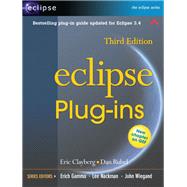
| Foreword by Skip McGaughey | p. xxxiii |
| Foreword by Simon Archer | p. xxxv |
| Preface | p. xxxvii |
| Using Eclipse Tools | p. 1 |
| Getting Started | p. 1 |
| The Eclipse Workbench | p. 3 |
| Setting Up Your Environment | p. 14 |
| Creating a Project | p. 19 |
| Navigating | p. 26 |
| Searching | p. 28 |
| Writing Code | p. 35 |
| Team Development Using CVS | p. 49 |
| Running Applications | p. 55 |
| Introduction to Debugging | p. 59 |
| Introduction to Testing | p. 63 |
| Introduction to Mylyn | p. 65 |
| Summary | p. 69 |
| A Simple Plug-in Example | p. 71 |
| The Favorites Plug-in | p. 71 |
| Creating a Plug-in Project | p. 72 |
| Reviewing the Generated Code | p. 77 |
| Building a Product | p. 86 |
| Installing and Running the Product | p. 92 |
| Debugging the Product | p. 94 |
| PDE Views | p. 96 |
| Writing Plug-in Tests | p. 99 |
| Book Samples | p. 105 |
| Summary | p. 106 |
| Eclipse Infrastructure | p. 107 |
| Structural Overview | p. 107 |
| Plug-in Directory or JAR file | p. 110 |
| Plug-in Manifest | p. 113 |
| Activator or Plug-in Class | p. 120 |
| Plug-in Model | p. 126 |
| Logging | p. 128 |
| Eclipse Plug-ins | p. 132 |
| Summary | p. 133 |
| The Standard Widget Toolkit | p. 135 |
| SWT History and Goals | p. 135 |
| SWT Widgets | p. 138 |
| Layout Management | p. 178 |
| Resource Management | p. 188 |
| GUI Builders | p. 190 |
| Summary | p. 191 |
| JFace Viewers | p. 193 |
| List-Oriented Viewers | p. 193 |
| Text Viewers | p. 211 |
| Summary | p. 214 |
| Commands and Actions | p. 215 |
| Commands | p. 216 |
| Menu and Toolbar Contributions | p. 220 |
| Handlers | p. 236 |
| Key Bindings | p. 238 |
| IAction versus IActionDelegate | p. 240 |
| Workbench Window Actions | p. 242 |
| Object Actions | p. 257 |
| View Actions | p. 270 |
| Editor Actions | p. 277 |
| Actions and Key Bindings | p. 284 |
| RFRS Considerations | p. 286 |
| Summary | p. 287 |
| Views | p. 289 |
| View Declaration | p. 291 |
| View | |
| View Commands | p. 313 |
| Linking the View | p. 336 |
| Saving View State | p. 340 |
| Testing | p. 345 |
| Image Caching | p. 346 |
| Auto-sizing Table Columns | p. 348 |
| RFRS Considerations | p. 348 |
| Summary | p. 352 |
| Editors | p. 353 |
| Editor Declaration | |
| Table of Contents provided by Publisher. All Rights Reserved. |
The New copy of this book will include any supplemental materials advertised. Please check the title of the book to determine if it should include any access cards, study guides, lab manuals, CDs, etc.
The Used, Rental and eBook copies of this book are not guaranteed to include any supplemental materials. Typically, only the book itself is included. This is true even if the title states it includes any access cards, study guides, lab manuals, CDs, etc.